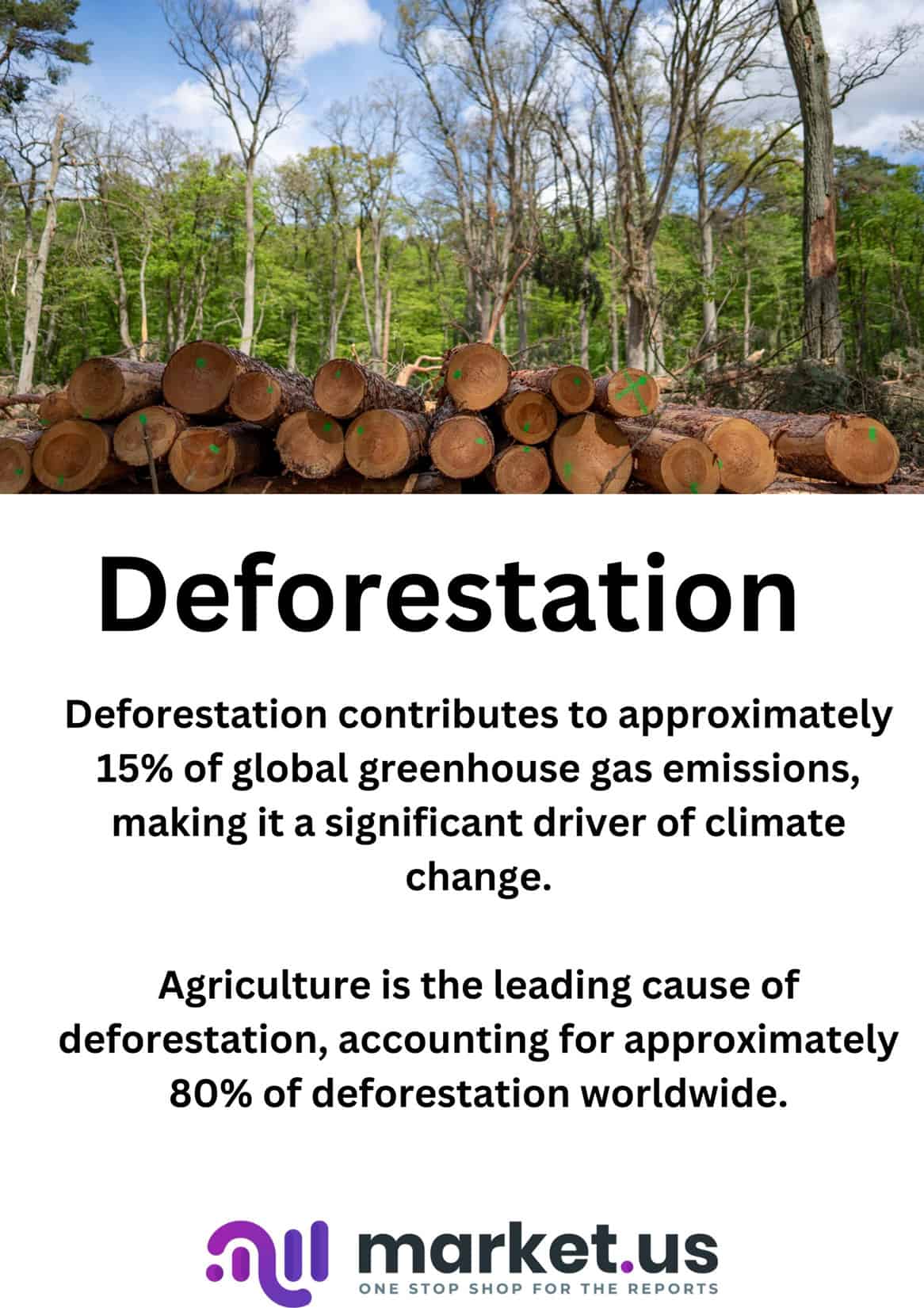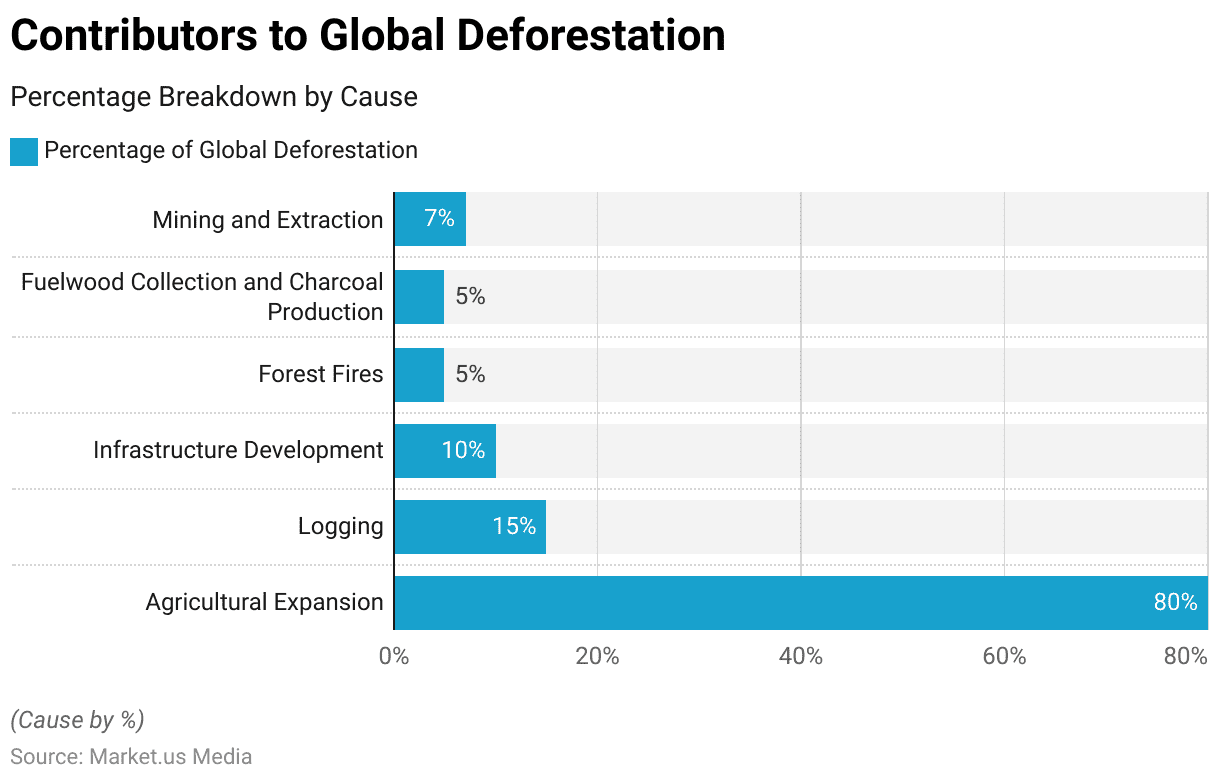Table of Contents
- Introduction
- Editor’s Choice
- Deforestation Statistics – Worldwide
- Causes – Deforestation Statistics
- Deforestation Statistics – Environmental Impact
- Deforestation Statistics – Efforts to Combat
- Amazon Deforestation
- Deforestation in Congo Basin Statistics
- Deforestation in Southeast Asia
- Deforestation Statistics by Country
- Recent Developments
- Key Takeaways
- FAQs
Introduction
Deforestation Statistics: Deforestation is the process of clearing or removal of forests or woodlands, typically for agriculture, logging, or urbanization.
It is a significant environmental issue with far-reaching consequences for biodiversity, climate change, and human livelihoods. Deforestation has been a cause for concern globally due to its detrimental effects on the planet.

Editor’s Choice
- The Global Smart Agriculture Market is anticipated to be USD 60.1 billion by 2033. It is estimated to record a steady CAGR of 11.3% in the Forecast period 2023 to 2033. It is likely to total USD 20.6 billion in 2023.
- Approximately 14.8 million hectares of forest are lost as of June 2023.
- The world’s forests have decreased by about 31% since the beginning of agriculture.
- The largest contributor to deforestation is agricultural expansion, accounting for about 70% of deforestation in tropical regions.
- The Amazon rainforest has experienced significant deforestation, with over 17% of the forest cover lost in the last 50 years.
- Southeast Asia has one of the highest deforestation rates globally, with an estimated loss of 15.8 million hectares between 2001 and 2022.
- Deforestation contributes to approximately 15% of global greenhouse gas emissions, making it a significant driver of climate change.
- Deforestation affects biodiversity, with an estimated 80% of terrestrial species living in forests.
(Source: The World Counts, World Bank, Union of Concerned Scientists, National Geographic, Global Forest Watch, Intergovernmental Panel on Climate Change, World Wildlife Fund)

Deforestation Statistics – Worldwide
- 10,000 years ago, 71% of the Earth’s land surface (10.6 billion hectares) was covered by forests, shrubs, and wild grasslands.
- Today, approximately half of this land is predominantly used for agriculture, grazing, and urban settlements.
- The current total surface covered by forests and grasslands has decreased to around 4.1 billion hectares.
- Forest loss is occurring at a rapid pace, equivalent to losing forests at a rate of 27 soccer fields per minute.
- Over 4.2 million hectares of tree cover was lost in Russia, which includes both deforestation and natural causes such as fire.
- Approximately 3.3 million hectares of tree cover were lost in Brazil.
- Global tree cover loss has exceeded 20 million hectares per year for most of the past decade.
- As of 2021, the Southeast Asian rainforest was estimated to be a net carbon emitter, with emissions exceeding its removal capacity. In the Amazon, emissions, and sinks were nearly balanced.
- Large-scale forestry operations in managed forests and tree plantations led to the loss of approximately 6.7 billion hectares of tree cover. Commodity-driven deforestation and urbanization contributed to around 4.9 million hectares of tree cover loss.
(Source: EARTH ORG, Statista)

Causes – Deforestation Statistics
- Agricultural Expansion
- Agriculture is the leading cause of deforestation, accounting for approximately 80% of deforestation worldwide.
- Small-scale farmers are responsible for 25% of global deforestation, while commercial agriculture contributes to the remaining 75%.
- Logging
- Logging for timber and wood products is a significant driver of deforestation, especially in tropical rainforests.
- It is estimated that logging accounts for around 15% of global deforestation.
- Infrastructure Development
- The construction of roads, dams, mining operations, and urban expansion leads to deforestation.
- Infrastructure development is responsible for roughly 10% of global deforestation.
- Forest Fires
- Forest fires, both natural and human-caused, contribute to deforestation.
- While natural fires are a natural part of some ecosystems, human-induced fires, such as slash-and-burn agriculture, exacerbate deforestation.
- Forest fires are responsible for approximately 5% of global deforestation.
- Fuelwood Collection and Charcoal Production
- The reliance on wood fuel for cooking and heating in many developing countries drives deforestation.
- Fuelwood collection and charcoal production account for about 5% of global deforestation.
- Mining and Extraction
- Mining activities, including minerals, oil, and gas, often involve clearing forests and destroying ecosystems.
- Mining contributes to approximately 7% of global deforestation.

Deforestation Statistics – Environmental Impact
- Each year, approximately 50,000 species are lost due to deforestation.
- Rainforest ingredients contribute to 25% of Western drugs and pharmaceuticals.
- The rainforest is a vital source of 25% of all cancer-fighting drugs.
- Alarmingly, 75% of tropical rainforests have lost their ability to adequately recover from wildfires and drought.
- Deforestation is a major driver of biodiversity loss, with an estimated 80% of terrestrial biodiversity residing in forests.
- Every minute, an area equivalent to 27 football fields is lost, resulting in the extinction of countless plant and animal species.
- Deforestation accounts for approximately 10% to 15% of global greenhouse gas emissions.
- Tropical deforestation alone is responsible for 10% of global carbon emissions, more than the entire global transportation sector.
(Source: tonerbuzz, World Wildlife Fund)
Deforestation Statistics – Efforts to Combat
- Approximately 30% of the earth’s land surface is covered by forests.
- Global forest area loss has decreased from 8.3 million hectares per year in the 1990s to 4.7 million hectares per year between 2010 and 2020.
- As of 2020, about 18% of the world’s forests are designated as protected areas.
- Global Forest Watch reported that the world lost 12 million hectares (30 million acres) of tree cover in 2020, which is equivalent to losing a football field of primary forest every 3.2 seconds.
- According to the Food and Agriculture Organization (FAO), an estimated 10 million hectares (24.7 million acres) of forests are lost annually, contributing to approximately 12-20% of global greenhouse gas emissions.
- The Amazon rainforest, one of the world’s most important ecosystems, lost approximately 17% of its total area in the last 50 years.
- Brazil had the highest rate of deforestation in the world, with over 1.7 million hectares (4.2 million acres) of tree cover loss in 2020 alone.
- The United Nations Environment Programme (UNEP) estimates that about 80% of the world’s terrestrial biodiversity is found in forests, highlighting the critical importance of protecting and conserving them.
(Source: FAO, World Bank, Global Forest Watch, National Geographic, UNEP)
Amazon Deforestation
- The Amazon rainforest lost approximately 8,054 square kilometers (3,103 square miles) of forest cover in 2020.
- Between 2000 and 2020, the Amazon rainforest lost around 513,016 square kilometers (198,077 square miles) of forest, an area roughly equivalent to the size of Spain. (Source: Global Forest Watch)
- The annual deforestation rate in the Brazilian Amazon decreased by 70% between 2004 and 2019, from 27,772 square kilometers (10,722 square miles) to 8,054 square kilometers (3,103 square miles).
- The main drivers of deforestation in the Brazilian Amazon are illegal logging, large-scale agriculture (primarily cattle ranching and soybean production), and infrastructure development.
- The Brazilian Amazon contains a network of protected areas, including national parks, sustainable use reserves, and indigenous territories, covering approximately 45% of the region.
- The Amazon rainforest is one of the most biodiverse regions on the planet, housing an estimated 10% of the world’s known species. Deforestation poses a severe threat to this unique ecosystem and its wildlife.
(Source: Global Forest Watch, Instituto Socioambiental, World Wildlife Fund)
Take advantage of our unbeatable offer - buy now!

Deforestation in Congo Basin Statistics
- The Congo Basin lost an estimated 4,000 square kilometers (1,544 square miles) of forest per year between 2010 and 2020.
- Deforestation rates in the Congo Basin increased by 9% between 2018 and 2019.
- The Congo Basin lost approximately 1,479 square kilometers (571 square miles) of primary forest in 2020.
(Source: World Resources Institute, Global Forest Watch)
Deforestation in Southeast Asia
Indonesia
- Indonesia lost approximately 4,709 square kilometers (1,817 square miles) of primary forest in 2020.
- Between 2001 and 2020, Indonesia lost approximately 36,000 square kilometers (13,900 square miles) of primary forest, an area roughly equivalent to the size of Belgium.
(Source: Global Forest Watch)
Malaysia
- Malaysia lost around 559 square kilometers (216 square miles) of forest cover in 2020.
- Between 2001 and 2020, Malaysia lost approximately 12,000 square kilometers (4,600 square miles) of primary forest, an area roughly equivalent to the size of Connecticut.
(Source: Global Forest Watch)
Myanmar (Burma)
- Myanmar lost approximately 1,089 square kilometers (420 square miles) of forest cover in 2020.
- Between 2001 and 2020, Myanmar lost approximately 24,000 square kilometers (9,300 square miles) of primary forest, an area roughly equivalent to the size of West Virginia.
(Source: Global Forest Watch)
Vietnam
- Myanmar lost approximately 1,089 square kilometers (420 square miles) of forest cover in 2020.
- Between 2001 and 2020, Myanmar lost approximately 24,000 square kilometers (9,300 square miles) of primary forest, an area roughly equivalent to the size of West Virginia.
(Source: Global Forest Watch)
Cambodia
- Myanmar lost approximately 1,089 square kilometers (420 square miles) of forest cover in 2020.
- Between 2001 and 2020, Myanmar lost approximately 24,000 square kilometers (9,300 square miles) of primary forest, an area roughly equivalent to the size of West Virginia.
(Source: Global Forest Watch)
Deforestation Statistics by Country
- Brazil: Between August 2019 and July 2020, Brazil lost 11,088 square kilometers of forest, a 9.5% increase compared to the previous year.
- Indonesia: From 2001 to 2019, Indonesia lost approximately 26.6 million hectares of forest, making it one of the highest deforestation rates globally.
- Democratic Republic of Congo: The Democratic Republic of Congo lost an average of 0.48 million hectares of forest per year between 2001 and 2019.
- Malaysia: Malaysia lost around 2.9 million hectares of forest between 2001 and 2019.
- Bolivia: Between 2001 and 2019, Bolivia lost approximately 7.8 million hectares of forest.
- Paraguay: Paraguay lost around 3.7 million hectares of forest between 2001 and 2019.
- Cambodia: Cambodia lost approximately 1.5 million hectares of forest between 2001 and 2019.
- Myanmar (Burma): Myanmar lost around 5.2 million hectares of forest between 2001 and 2019.
- Nigeria: Nigeria lost approximately 4.6 million hectares of forest between 2001 and 2019.
- Australia: Australia lost around 6.3 million hectares of forest between 2001 and 2019.
(Source: National Institute for Space Research – INPE, Global Forest Watch)
Recent Developments
Increase in Deforestation Rates:
- Global Forest Watch reported a 12% increase in tree cover loss in 2020.
- Approximately 12.2 million hectares of tree cover were lost worldwide during this period.
Impact of Agricultural Expansion:
- Large-scale agricultural activities drive significant deforestation.
- Examples include cattle ranching and soybean cultivation, especially in regions like the Amazon rainforest and parts of Africa.
- Demand for commodities like beef, soy, and palm oil fuels deforestation in these areas.
Corporate Commitments to Zero Deforestation:
- Many corporations have adopted zero-deforestation policies in their supply chains.
- This is particularly prevalent in industries such as palm oil, soy, and timber.
- The aim is to source products sustainably and protect forest ecosystems.
Government Policies and Enforcement:
- Governments are implementing policies and regulations to combat deforestation.
- Measures include strengthening enforcement against illegal logging and promoting sustainable forest management practices.
Impact on Biodiversity and Climate:
- Deforestation poses significant threats to biodiversity.
- It also contributes to climate change by releasing carbon dioxide into the atmosphere.
- Habitat destruction and species extinction are among the adverse effects of forest loss.
Investments in Reforestation and Restoration:
- Efforts to counteract deforestation include investments in reforestation and restoration projects.
- Initiatives like the Bonn Challenge aim to restore 350 million hectares of degraded and deforested land by 2030, contributing to global reforestation efforts.
Key Takeaways
Deforestation Statistics – Deforestation is a critical global issue that demands immediate attention and action.
The destruction of forests has far-reaching consequences, including the loss of biodiversity, disruption of ecosystems, contribution to climate change, and threats to indigenous communities and their way of life.
By prioritizing the preservation and restoration of forests, we can mitigate the environmental and social impacts of deforestation, safeguard the planet’s biodiversity, and ensure a sustainable future for generations to come.
FAQs
Deforestation refers to the clearing, removal, or destruction of forests or wooded areas, typically done to make space for agriculture, urbanization, logging, or other human activities.
Forests are home to a significant portion of the Earth’s biodiversity. Deforestation leads to habitat loss, fragmentation, and degradation, causing the displacement and extinction of many plant and animal species. It disrupts ecosystems and reduces the resilience of natural environments to adapt to changes.
Some countries with historically high deforestation rates include Brazil, Indonesia, Russia, and the Democratic Republic of Congo. However, it’s important to note that deforestation rates can change over time due to various factors and government policies.
Discuss your needs with our analyst
Please share your requirements with more details so our analyst can check if they can solve your problem(s)



